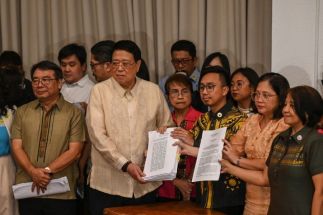Amazing political rigodon

February 3, 2007 | 12:00am
It’s election time again, and as is the perennial case in Philippine politics, it is a time for personalities, not issues or platforms. While we do concede that some newcomers to the field espouse a platform or two, others don’t even bother. It is because here in the Philippines, we have a multi-party system, with no cap on the number and party membership is dictated not by principles or issues but pure and simple politics. As a result, party members do a rigodon number regularly, so often you would be dizzy identifying correctly the politicians’ affiliation at any given time. Party hopping may be a preoccupation of our local politicians, but in the US, they wear their badge of affiliation boldly and proudly. There, they are divided by issues, not by personalities, and on the rare instances when they see eye to eye on certain issues, you can be sure it is a coming to terms for the greater good of the citizenry. For instance, members of both camps now realize that the Republicans’ bold steps taken towards a broader free trade market has resulted in fewer jobs for Americans. Why? Because more factories are being put up in other less developed countries. Good for us here where the grass is less green, but the American legislators are now looking at the prospects of protectionism. The Democrats are opposed to the Bush administration’s tax cuts because these are more for the privileged. For instance, this Republican stance has cut taxes on dividends, and capital gains. Can the ordinary worker benefit from this?
We are supposed to have a united opposition. It is united insofar as their disdain for the current administration is concerned, but national issues have been set aside for now – they cannot be bothered by these during election times. Now, the race is on for the prized senate seats, and depending on who you are listening to, the united opposition has different slates because the opposition, supposedly united, has several titular heads, each with his own design and direction. How united is that?
Educating the voters continues to be a Herculean task. While election time may be a particularly colorful time not only in the metropolis but in the rural areas as well, one does not hear of issues being discussed in the barbershop or in the makeshift benches around a favorite sari-sari store. The talk centers on personalities – who is now affiliated with Erap, who are the latest actors/actresses throwing their hat into the ring, etc. There is hardly any room for discussion in these rings for the more basic issues like education, health care, etc.
Speaking of health care, let me add to my column two issues ago on the prohibitive cost of drugs in the country today.
In that column, I mentioned that we lag behind India, Pakistan and Thailand in protecting the common interest of the masses insofar as the prices of medicines are concerned. Imagine that the common pain reliever Ponstan is sold here at P24-25 each, while in India, it is reportedly sold for P3-4 each (equivalent) only! If drugs here are sold up to 10 times more than in India, how can our poor survive? Our patients indeed are looked upon not with compassion but with market value.
The pharmaceutical business is one of the biggest in the world, maybe second only to the oil business. Estimates put the profits of the top five pharmaceutical companies to be $2.6 billion, in the next 100 hours, and their CEOs about $2 million richer within this time frame, as reported by a top business publication. The Indian pharmaceutical industry alone is already worth $7.5 billion, and this figure is already with price controls built into the system. The World Health Organization lists 354 essential drugs, and of this number, 74 drugs are placed in strict control by the Indian government. The government is mulling on increasing the net of price control, and this expansion is seen to cover about 40 percent of pharmaceutical sales in India. They have a government body tasked with nothing but overseeing the prices of medicines in the country, and if a particular drug increases by as much as 20 percent in a year, it calls for an investigation. I wonder if we have such guidelines here. Secretary Obet Pagdanganan is filling a tall order in trying to bring down the cost of medicines in the country, and already, he is in the middle of a raging controversy with some drug manufacturers because of his efforts. His Botika Ng Bayan is God-sent for many impoverished Filipinos, but the project still has a long way to go in reaching the goal of having medicines readily available for as many Filipinos as possible. I hope many such Botikas mushroom in as many areas as possible, and I certainly hope to see one or two in my community soonest.
The argument of the pharmaceutical companies is that price control will kill the small pharma companies. Did you know that wholesalers and retailers of medicines are reported to tack on as much as 800 percent to 1,000 percent? Even if you cut this figure in half, I figure these companies will still be able to make a killing (pardon the pun) on retail sales of the drugs.
For the big boys in the industry, their argument is that wider price control will effectively harm their research and development programs. Admittedly, these programs could run into years and cost a lot of money. But that is why we have patent laws that protect these companies for an incredulously long period.
They also talk of mass lay-offs as a result of aggressive price controls in the market. There must be other corners to cut in their corporate structure. Why is it that it is always the smallest of the boys that gets the whipping, and the biggest boys don’t even get nicked?
The big controversy about the pharmaceutical business is understandable. India is the fourth largest market in the world by volume, but in sales, it only ranks 13th precisely because of the price controls enforced. They have more than 1,000 firms engaged in the drugs business. It is so competitive that they have as much as 30 manufacturers for a single drug. Being one of the most competitive markets globally in this field, it is now regarded as a test ground for governing rules which could have global impact. The big pharmaceutical companies are battling it out for more friendly business environment for them. They are seeking more incentives, tax or otherwise from the Indian government to offset the price controls. In return, they have a peace offering - they agree that 800 percent to 1,000 percent mark-up is ridiculously high. They are willing to shave this off to as much as 50 percent. Effectively, this would reduce the retail prices of medicines to as low as 40 percent to 50 percent.
They also agree to a blanket reduction of prices on a one-shot deal basis on all the essential drugs listed by the WHO (World Health Organization, the international body whom all pharma countries recognize as the single most influential body in the business) all 354 of them, but only as much as five percent. Is this a significant reduction, considering the figures earlier cited?
They are further offering to reduce by as much as 50 percent the cost of all drugs to be sold to the government for their health programs. Now this is where we can pick up from this Asean neighbor. If we can have all multinationals support our health care programs in the country by way of subsidized pricing for all legitimate government purchases, it is good news for the countryside. The problem, of course, is this is going to feed right into our corrupt bureaucracies, but this should not be a factor in swinging this deal from these multinationals. That is our problem alone.
In return for such peace offerings, these multinationals are petitioning the Indian government to scrap all price controls. Instead, they want to replace this with a special body that will monitor the prices of medicines sold in the country. But they already have this in place in India!
Here in the Philippines the controversies are only just beginning, with Sec. Obet Pagdanganan stirring the pot. The pharmaceutical multinationals that have set up camp here have been enjoying a good business environment for a long time. They’ve had it so good for so long it’s time to give back some. It will not hurt for the government to initiate some action on this, and for the politicians to stir the pot a little so that something is done towards this end.
During Bonifacio Day celebrations last year, which was held at the Bonifacio monument in Caloocan City, the AFP was represented by the 1501st CMDR Col. Joseph Galam together with his deputy Lt. Col. Roberto G. Gamboa Jr.
After the civic-military parade that marked the celebrations, Caloocan City Mayor Enrico R. Echiverri was presented by Col. Galam the Arescom PA special order designating the good mayor as the 1501st BDE Executive Officer with the rank of Lt. Colonel together with a set of battle dress & uniform.
Starting January 2007 the Arescom PA has Brig. General Luini C. Mirar AFP, a former brigade commander assigned in Mindanao, as the new Commanding General-our congratulations to you, General.
Mabuhay!!! Be proud to be a Filipino.
For comments: (e-mail) [email protected]
We are supposed to have a united opposition. It is united insofar as their disdain for the current administration is concerned, but national issues have been set aside for now – they cannot be bothered by these during election times. Now, the race is on for the prized senate seats, and depending on who you are listening to, the united opposition has different slates because the opposition, supposedly united, has several titular heads, each with his own design and direction. How united is that?
Educating the voters continues to be a Herculean task. While election time may be a particularly colorful time not only in the metropolis but in the rural areas as well, one does not hear of issues being discussed in the barbershop or in the makeshift benches around a favorite sari-sari store. The talk centers on personalities – who is now affiliated with Erap, who are the latest actors/actresses throwing their hat into the ring, etc. There is hardly any room for discussion in these rings for the more basic issues like education, health care, etc.
In that column, I mentioned that we lag behind India, Pakistan and Thailand in protecting the common interest of the masses insofar as the prices of medicines are concerned. Imagine that the common pain reliever Ponstan is sold here at P24-25 each, while in India, it is reportedly sold for P3-4 each (equivalent) only! If drugs here are sold up to 10 times more than in India, how can our poor survive? Our patients indeed are looked upon not with compassion but with market value.
The pharmaceutical business is one of the biggest in the world, maybe second only to the oil business. Estimates put the profits of the top five pharmaceutical companies to be $2.6 billion, in the next 100 hours, and their CEOs about $2 million richer within this time frame, as reported by a top business publication. The Indian pharmaceutical industry alone is already worth $7.5 billion, and this figure is already with price controls built into the system. The World Health Organization lists 354 essential drugs, and of this number, 74 drugs are placed in strict control by the Indian government. The government is mulling on increasing the net of price control, and this expansion is seen to cover about 40 percent of pharmaceutical sales in India. They have a government body tasked with nothing but overseeing the prices of medicines in the country, and if a particular drug increases by as much as 20 percent in a year, it calls for an investigation. I wonder if we have such guidelines here. Secretary Obet Pagdanganan is filling a tall order in trying to bring down the cost of medicines in the country, and already, he is in the middle of a raging controversy with some drug manufacturers because of his efforts. His Botika Ng Bayan is God-sent for many impoverished Filipinos, but the project still has a long way to go in reaching the goal of having medicines readily available for as many Filipinos as possible. I hope many such Botikas mushroom in as many areas as possible, and I certainly hope to see one or two in my community soonest.
The argument of the pharmaceutical companies is that price control will kill the small pharma companies. Did you know that wholesalers and retailers of medicines are reported to tack on as much as 800 percent to 1,000 percent? Even if you cut this figure in half, I figure these companies will still be able to make a killing (pardon the pun) on retail sales of the drugs.
For the big boys in the industry, their argument is that wider price control will effectively harm their research and development programs. Admittedly, these programs could run into years and cost a lot of money. But that is why we have patent laws that protect these companies for an incredulously long period.
They also talk of mass lay-offs as a result of aggressive price controls in the market. There must be other corners to cut in their corporate structure. Why is it that it is always the smallest of the boys that gets the whipping, and the biggest boys don’t even get nicked?
The big controversy about the pharmaceutical business is understandable. India is the fourth largest market in the world by volume, but in sales, it only ranks 13th precisely because of the price controls enforced. They have more than 1,000 firms engaged in the drugs business. It is so competitive that they have as much as 30 manufacturers for a single drug. Being one of the most competitive markets globally in this field, it is now regarded as a test ground for governing rules which could have global impact. The big pharmaceutical companies are battling it out for more friendly business environment for them. They are seeking more incentives, tax or otherwise from the Indian government to offset the price controls. In return, they have a peace offering - they agree that 800 percent to 1,000 percent mark-up is ridiculously high. They are willing to shave this off to as much as 50 percent. Effectively, this would reduce the retail prices of medicines to as low as 40 percent to 50 percent.
They also agree to a blanket reduction of prices on a one-shot deal basis on all the essential drugs listed by the WHO (World Health Organization, the international body whom all pharma countries recognize as the single most influential body in the business) all 354 of them, but only as much as five percent. Is this a significant reduction, considering the figures earlier cited?
They are further offering to reduce by as much as 50 percent the cost of all drugs to be sold to the government for their health programs. Now this is where we can pick up from this Asean neighbor. If we can have all multinationals support our health care programs in the country by way of subsidized pricing for all legitimate government purchases, it is good news for the countryside. The problem, of course, is this is going to feed right into our corrupt bureaucracies, but this should not be a factor in swinging this deal from these multinationals. That is our problem alone.
In return for such peace offerings, these multinationals are petitioning the Indian government to scrap all price controls. Instead, they want to replace this with a special body that will monitor the prices of medicines sold in the country. But they already have this in place in India!
Here in the Philippines the controversies are only just beginning, with Sec. Obet Pagdanganan stirring the pot. The pharmaceutical multinationals that have set up camp here have been enjoying a good business environment for a long time. They’ve had it so good for so long it’s time to give back some. It will not hurt for the government to initiate some action on this, and for the politicians to stir the pot a little so that something is done towards this end.
After the civic-military parade that marked the celebrations, Caloocan City Mayor Enrico R. Echiverri was presented by Col. Galam the Arescom PA special order designating the good mayor as the 1501st BDE Executive Officer with the rank of Lt. Colonel together with a set of battle dress & uniform.
Starting January 2007 the Arescom PA has Brig. General Luini C. Mirar AFP, a former brigade commander assigned in Mindanao, as the new Commanding General-our congratulations to you, General.
Mabuhay!!! Be proud to be a Filipino.
For comments: (e-mail) [email protected]
BrandSpace Articles
<
>
- Latest
- Trending
Trending
Latest
Trending
Latest
Recommended




























